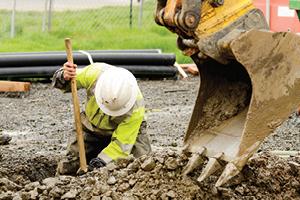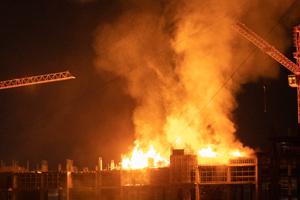How to keep your spray booth up and painting
A fire in your spray booth can shut down the painting operation and injure employees. It can also damage equipment, the building and cause your business to shut down for repairs. Valuable production time can be lost and impact the bottom line. Following are some guidelines and some tips to keep your painting operation up and painting:
Know the basics
The key to success is clear direction and support from top management. Listed below are basic best practices that should be implemented for spray painting operations:
- Keep radios, fans and other electrical equipment out of the spray booth and the area immediately adjacent to the booth, unless specifically listed for use in the environment.
- Replace filter for exhaust systems regularly; don’t allow them to collect so much residue as to negatively impact the functionality of the exhaust system.
- Replace missing filters; spray operations only be conducted when there is a full bank of filters for the exhaust system.
- Operate ventilation system while spraying.
- Allow only the minimum quantity of flammable and combustible liquids required for operations.
- Protect sprinkler heads from overspray by covering with a thin cellophane or paper bag. It should be replaced frequently.
- Use approved metal waste containers for rags and waste impregnated with finishing material. The contents of these containers should be removed from the building at the end of each work shift or at least daily.
- Store flammable liquids in listed or approved safety cans.
Maintain the booth
Maintenance of equipment is a key activity that helps reduce the potential of a fire event and the severity of a fire. Follow these spray booth maintenance tips:
- Keep booth surfaces free from a build-up of overspray deposits and residues; simplify cleaning by using special or “strippable” coatings on interior booth walls.
- Scrapers and/or other tools used for cleaning should be made of non-sparking materials.
- Check your exhaust ductwork and fan blades regularly and remove any build-up. If frequent cleaning is needed, it may be an indication of filter problems.
- Wet down scrapings and sweepings and remove from the building. They should never be left in piles on the floor or in uncovered containers.
Eliminate and control ignition sources
A fire needs an ignition source; listed below are controls needed for ignition sources:
- Allow only properly rated electrical equipment in the spray booth and areas adjacent to spray booth.
- Eliminate static charge by grounding metal parts of spray booths, agitators, exhaust ducts and pipe systems that distribute flammable/combustible liquids.
- Prohibit smoking within 20 ft. of a spray area and post “No Smoking” signs.
- Maintain at least a 35 ft. clearance between spray operations and spark-producing equipment such as cutting and welding.
Train your employees
Trained employees help ensure operations are conducted safely. At a minimum, employees should be trained in these topics:
- How to safely handle, store and use flammable and combustible liquids.
- Understand how to implement emergency, operational and maintenance procedures.
- To be aware of potential health hazards, nature of the hazard, and use of protective and emergency equipment.
Hanover Risk Solutions
Contact your Hanover Risk Solutions Consultant to meet with you to review your specific operation. He or she can provide guidance on controls that can be implemented to reduce your exposure to a loss in spray painting operation.
The recommendation(s), advice and contents of this material are provided for informational purposes only and do not purport to address every possible legal obligation, hazard, code violation, loss potential or exception to good practice. The Hanover Insurance Company and its affiliates and subsidiaries ("The Hanover") specifically disclaim any warranty or representation that acceptance of any recommendations or advice contained herein will make any premises, property or operation safe or in compliance with any law or regulation. Under no circumstances should this material or your acceptance of any recommendations or advice contained herein be construed as establishing the existence or availability of any insurance coverage with The Hanover. By providing this information to you, The Hanover does not assume (and specifically disclaims) any duty, undertaking or responsibility to you. The decision to accept or implement any recommendation(s) or advice contained in this material must be made by you.
LC OCT 2018-342
171-1750 (1/16)
Related resources
How to keep your spray booth up and painting
A fire in your spray booth can shut down the painting operation and injure employees. It can also damage equipment, the building and cause your business to shut down for repairs. Valuable production time can be lost and impact the bottom line. Following are some guidelines and some tips to keep your painting operation up and painting:
Know the basics
The key to success is clear direction and support from top management. Listed below are basic best practices that should be implemented for spray painting operations:
- Keep radios, fans and other electrical equipment out of the spray booth and the area immediately adjacent to the booth, unless specifically listed for use in the environment.
- Replace filter for exhaust systems regularly; don’t allow them to collect so much residue as to negatively impact the functionality of the exhaust system.
- Replace missing filters; spray operations only be conducted when there is a full bank of filters for the exhaust system.
- Operate ventilation system while spraying.
- Allow only the minimum quantity of flammable and combustible liquids required for operations.
- Protect sprinkler heads from overspray by covering with a thin cellophane or paper bag. It should be replaced frequently.
- Use approved metal waste containers for rags and waste impregnated with finishing material. The contents of these containers should be removed from the building at the end of each work shift or at least daily.
- Store flammable liquids in listed or approved safety cans.
Maintain the booth
Maintenance of equipment is a key activity that helps reduce the potential of a fire event and the severity of a fire. Follow these spray booth maintenance tips:
- Keep booth surfaces free from a build-up of overspray deposits and residues; simplify cleaning by using special or “strippable” coatings on interior booth walls.
- Scrapers and/or other tools used for cleaning should be made of non-sparking materials.
- Check your exhaust ductwork and fan blades regularly and remove any build-up. If frequent cleaning is needed, it may be an indication of filter problems.
- Wet down scrapings and sweepings and remove from the building. They should never be left in piles on the floor or in uncovered containers.
Eliminate and control ignition sources
A fire needs an ignition source; listed below are controls needed for ignition sources:
- Allow only properly rated electrical equipment in the spray booth and areas adjacent to spray booth.
- Eliminate static charge by grounding metal parts of spray booths, agitators, exhaust ducts and pipe systems that distribute flammable/combustible liquids.
- Prohibit smoking within 20 ft. of a spray area and post “No Smoking” signs.
- Maintain at least a 35 ft. clearance between spray operations and spark-producing equipment such as cutting and welding.
Train your employees
Trained employees help ensure operations are conducted safely. At a minimum, employees should be trained in these topics:
- How to safely handle, store and use flammable and combustible liquids.
- Understand how to implement emergency, operational and maintenance procedures.
- To be aware of potential health hazards, nature of the hazard, and use of protective and emergency equipment.
Hanover Risk Solutions
Contact your Hanover Risk Solutions Consultant to meet with you to review your specific operation. He or she can provide guidance on controls that can be implemented to reduce your exposure to a loss in spray painting operation.
The recommendation(s), advice and contents of this material are provided for informational purposes only and do not purport to address every possible legal obligation, hazard, code violation, loss potential or exception to good practice. The Hanover Insurance Company and its affiliates and subsidiaries ("The Hanover") specifically disclaim any warranty or representation that acceptance of any recommendations or advice contained herein will make any premises, property or operation safe or in compliance with any law or regulation. Under no circumstances should this material or your acceptance of any recommendations or advice contained herein be construed as establishing the existence or availability of any insurance coverage with The Hanover. By providing this information to you, The Hanover does not assume (and specifically disclaims) any duty, undertaking or responsibility to you. The decision to accept or implement any recommendation(s) or advice contained in this material must be made by you.
LC OCT 2018-342
171-1750 (1/16)
Related resources
How to keep your spray booth up and painting
A fire in your spray booth can shut down the painting operation and injure employees. It can also damage equipment, the building and cause your business to shut down for repairs. Valuable production time can be lost and impact the bottom line. Following are some guidelines and some tips to keep your painting operation up and painting:
Know the basics
The key to success is clear direction and support from top management. Listed below are basic best practices that should be implemented for spray painting operations:
- Keep radios, fans and other electrical equipment out of the spray booth and the area immediately adjacent to the booth, unless specifically listed for use in the environment.
- Replace filter for exhaust systems regularly; don’t allow them to collect so much residue as to negatively impact the functionality of the exhaust system.
- Replace missing filters; spray operations only be conducted when there is a full bank of filters for the exhaust system.
- Operate ventilation system while spraying.
- Allow only the minimum quantity of flammable and combustible liquids required for operations.
- Protect sprinkler heads from overspray by covering with a thin cellophane or paper bag. It should be replaced frequently.
- Use approved metal waste containers for rags and waste impregnated with finishing material. The contents of these containers should be removed from the building at the end of each work shift or at least daily.
- Store flammable liquids in listed or approved safety cans.
Maintain the booth
Maintenance of equipment is a key activity that helps reduce the potential of a fire event and the severity of a fire. Follow these spray booth maintenance tips:
- Keep booth surfaces free from a build-up of overspray deposits and residues; simplify cleaning by using special or “strippable” coatings on interior booth walls.
- Scrapers and/or other tools used for cleaning should be made of non-sparking materials.
- Check your exhaust ductwork and fan blades regularly and remove any build-up. If frequent cleaning is needed, it may be an indication of filter problems.
- Wet down scrapings and sweepings and remove from the building. They should never be left in piles on the floor or in uncovered containers.
Eliminate and control ignition sources
A fire needs an ignition source; listed below are controls needed for ignition sources:
- Allow only properly rated electrical equipment in the spray booth and areas adjacent to spray booth.
- Eliminate static charge by grounding metal parts of spray booths, agitators, exhaust ducts and pipe systems that distribute flammable/combustible liquids.
- Prohibit smoking within 20 ft. of a spray area and post “No Smoking” signs.
- Maintain at least a 35 ft. clearance between spray operations and spark-producing equipment such as cutting and welding.
Train your employees
Trained employees help ensure operations are conducted safely. At a minimum, employees should be trained in these topics:
- How to safely handle, store and use flammable and combustible liquids.
- Understand how to implement emergency, operational and maintenance procedures.
- To be aware of potential health hazards, nature of the hazard, and use of protective and emergency equipment.
Hanover Risk Solutions
Contact your Hanover Risk Solutions Consultant to meet with you to review your specific operation. He or she can provide guidance on controls that can be implemented to reduce your exposure to a loss in spray painting operation.
The recommendation(s), advice and contents of this material are provided for informational purposes only and do not purport to address every possible legal obligation, hazard, code violation, loss potential or exception to good practice. The Hanover Insurance Company and its affiliates and subsidiaries ("The Hanover") specifically disclaim any warranty or representation that acceptance of any recommendations or advice contained herein will make any premises, property or operation safe or in compliance with any law or regulation. Under no circumstances should this material or your acceptance of any recommendations or advice contained herein be construed as establishing the existence or availability of any insurance coverage with The Hanover. By providing this information to you, The Hanover does not assume (and specifically disclaims) any duty, undertaking or responsibility to you. The decision to accept or implement any recommendation(s) or advice contained in this material must be made by you.
LC OCT 2018-342
171-1750 (1/16)
Related resources
How to keep your spray booth up and painting
A fire in your spray booth can shut down the painting operation and injure employees. It can also damage equipment, the building and cause your business to shut down for repairs. Valuable production time can be lost and impact the bottom line. Following are some guidelines and some tips to keep your painting operation up and painting:
Know the basics
The key to success is clear direction and support from top management. Listed below are basic best practices that should be implemented for spray painting operations:
- Keep radios, fans and other electrical equipment out of the spray booth and the area immediately adjacent to the booth, unless specifically listed for use in the environment.
- Replace filter for exhaust systems regularly; don’t allow them to collect so much residue as to negatively impact the functionality of the exhaust system.
- Replace missing filters; spray operations only be conducted when there is a full bank of filters for the exhaust system.
- Operate ventilation system while spraying.
- Allow only the minimum quantity of flammable and combustible liquids required for operations.
- Protect sprinkler heads from overspray by covering with a thin cellophane or paper bag. It should be replaced frequently.
- Use approved metal waste containers for rags and waste impregnated with finishing material. The contents of these containers should be removed from the building at the end of each work shift or at least daily.
- Store flammable liquids in listed or approved safety cans.
Maintain the booth
Maintenance of equipment is a key activity that helps reduce the potential of a fire event and the severity of a fire. Follow these spray booth maintenance tips:
- Keep booth surfaces free from a build-up of overspray deposits and residues; simplify cleaning by using special or “strippable” coatings on interior booth walls.
- Scrapers and/or other tools used for cleaning should be made of non-sparking materials.
- Check your exhaust ductwork and fan blades regularly and remove any build-up. If frequent cleaning is needed, it may be an indication of filter problems.
- Wet down scrapings and sweepings and remove from the building. They should never be left in piles on the floor or in uncovered containers.
Eliminate and control ignition sources
A fire needs an ignition source; listed below are controls needed for ignition sources:
- Allow only properly rated electrical equipment in the spray booth and areas adjacent to spray booth.
- Eliminate static charge by grounding metal parts of spray booths, agitators, exhaust ducts and pipe systems that distribute flammable/combustible liquids.
- Prohibit smoking within 20 ft. of a spray area and post “No Smoking” signs.
- Maintain at least a 35 ft. clearance between spray operations and spark-producing equipment such as cutting and welding.
Train your employees
Trained employees help ensure operations are conducted safely. At a minimum, employees should be trained in these topics:
- How to safely handle, store and use flammable and combustible liquids.
- Understand how to implement emergency, operational and maintenance procedures.
- To be aware of potential health hazards, nature of the hazard, and use of protective and emergency equipment.
Hanover Risk Solutions
Contact your Hanover Risk Solutions Consultant to meet with you to review your specific operation. He or she can provide guidance on controls that can be implemented to reduce your exposure to a loss in spray painting operation.
The recommendation(s), advice and contents of this material are provided for informational purposes only and do not purport to address every possible legal obligation, hazard, code violation, loss potential or exception to good practice. The Hanover Insurance Company and its affiliates and subsidiaries ("The Hanover") specifically disclaim any warranty or representation that acceptance of any recommendations or advice contained herein will make any premises, property or operation safe or in compliance with any law or regulation. Under no circumstances should this material or your acceptance of any recommendations or advice contained herein be construed as establishing the existence or availability of any insurance coverage with The Hanover. By providing this information to you, The Hanover does not assume (and specifically disclaims) any duty, undertaking or responsibility to you. The decision to accept or implement any recommendation(s) or advice contained in this material must be made by you.
LC OCT 2018-342
171-1750 (1/16)





